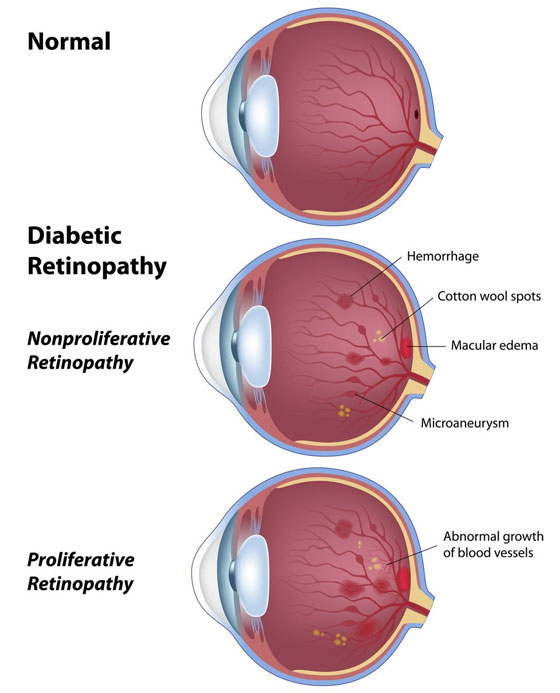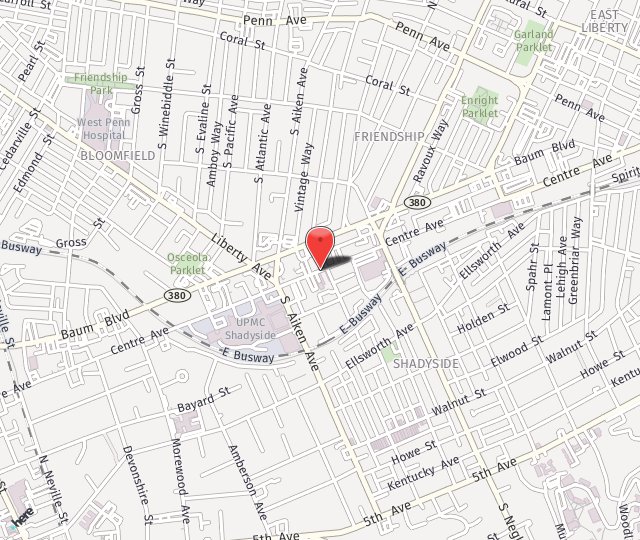Diabetes is a disease that affects all areas of your body—including your eyes. Eye care is especially important for people with diabetes because they are at increased risk of developing eye complications from the disease. In fact, diabetes is the leading cause of blindness in adults age 20 to 74.

Unfortunately, most people with diabetes will get some form of retinopathy, a disorder of the retina. The earlier problems are diagnosed, the more successful the treatments can be.
What is Diabetic Retinopathy?
Diabetic retinopathy is a disease of the small blood vessels that nourish the retina. It is especially prevalent in Type I or insulin-dependent diabetics. In some cases, blood vessels weaken and can begin to leak fluid, fatty or protein deposits, and blood, reducing the nourishment to the retina. The longer you’ve had diabetes, the more likely you are to have retinopathy.
What are the stages of Diabetic Retinopathy?
- Mild Nonproliferative Retinopathy. At this earliest stage, microaneurysms occur. They are small areas of swelling in the retina’s tiny blood vessels.
- Moderate Nonproliferative Retinopathy. As the disease progresses, some blood vessels that nourish the retina are blocked.
- Severe Nonproliferative Retinopathy. Many more blood vessels are blocked, depriving several areas of the retina of their blood supply. These areas of the retina send signals to the body to grow new blood vessels for nourishment.
- Proliferative Retinopathy. At this advanced stage, the signals sent by the retina for nourishment trigger the growth of new blood vessels. This condition is called proliferative retinopathy. These new blood vessels are abnormal and fragile. They grow along the retina and along the surface of the clear, vitreous gel that fills the inside of the eye. By themselves, these blood vessels do not cause symptoms or vision loss. However, they have thin, fragile walls. If they leak blood, severe vision loss and even blindness can result. See diagram.

If I am diabetic, what can I do to help my eyesight?
People who keep their blood sugar levels closer to normal are less likely to have retinopathy or will have milder forms.
What are the symptoms of Diabetic Retinopathy?
Your retina can be badly damaged before you notice any change in vision. Most people with nonproliferative retinopathy have no symptoms. Even with proliferative retinopathy, the more dangerous form, people sometimes have no symptoms until it is too late to treat them. For this reason, you should have your eyes examined regularly by one of the doctors at The Cataract & Laser Institute of Pittsburgh.
The earliest sign of diabetic retinopathy is usually the appearance of microaneurysms on the surface of the eye, which looks like small, red dots. Although diabetic retinopathy will eventually cause vision problems, vision loss usually doesn’t appear in the early onset of diabetic retinopathy.
I have Early Diabetic Retinopathy, what is the treatment?
If you have nonproliferative diabetic retinopathy, you may not need treatment right away. However, Dr. Chun will closely monitor your eyes to determine if and when you need treatment.
It may also be helpful to work with your diabetes doctor to find out if there are any additional steps you can take to improve your diabetes management.
I have Advanced Diabetic Retinopathy, what is the treatment?
If you have proliferative diabetic retinopathy, you may need prompt surgical treatment. Surgery often slows or stops the progression of diabetic retinopathy, but it’s not a cure. Because diabetes is a lifelong condition, future retinal damage and vision loss are possible. Even after treatment for diabetic retinopathy, you’ll need regular eye exams. At some point, additional treatment may be recommended.
Depending on the specific problems with your retina, treatment options for advanced diabetic retinopathy may include:
- Focal Laser Treatment. This laser treatment, also known as photocoagulation, can stop or slow the leakage of blood and fluid in the eye. During the procedure, leaks from abnormal blood vessels are treated with laser burns.
- Scatter Laser Treatment. This laser treatment, also known as panretinal photocoagulation, can shrink the abnormal blood vessels. During the procedure, the areas of the retina away from the macula are treated with scattered laser burns. The burns cause the abnormal new blood vessels to shrink and scar.
- Vitrectomy. This procedure can be used to remove blood from the middle of the eye (vitreous) as well as any scar tissue that’s tugging on the retina. During the procedure, the retinal disease specialist makes a tiny incision in your eye. Scar tissue and blood in the eye are removed with delicate instruments and replaced with a salt solution, which helps maintain your eye’s normal shape. Sometimes a gas bubble must be placed in the cavity of the eye to help reattach the retina.
What are other eye complications diabetes can cause?
Glaucoma
People with diabetes are 40% more likely to suffer from glaucoma than people without diabetes. The longer someone has had diabetes, the more common glaucoma is. Risk also increases with age.
Cataracts
People with diabetes are 60% more likely to develop cataracts. People with diabetes also tend to get cataracts at a younger age and have them progress faster.
Diabetic Macular Edema (DME)
DME is the leading cause of vision loss in patients with diabetic retinopathy. The capillary walls in your eyes may lose their ability to control the passage of substances between the blood and the retina. Fluid can leak into the part of the eye where focusing occurs, the macula. When the macula swells with fluid, it creates a condition called macular edema, in which vision blurs and can be lost entirely. Macular edema must be treated, but fortunately, treatment is usually effective at stopping and sometimes reversing vision loss.
There are two types of treatment for macular edema: focal laser therapy that slows the leakage of fluid, and medications that can be injected into the eye that slow the growth of new blood vessels and reduce the leakage of fluid into the macula.
Benjamin Chun from PRN Omega3 on Vimeo.




